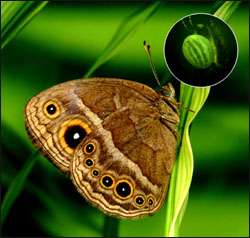|
By ELLEN GOLDBAUM
Contributing Editor
UB biologists who study butterfly wing patterns have inserted into
an African butterfly a marker gene from a jellyfish species, resulting
in the first transgenic butterflies that express DNA from another
species.
 |  UB
biologists have inserted into butterflies a marker gene from jellyfish
that results in the insects' fluorescent green eyes (inset).
|
The research will allow the biologists to begin exploring how novel
features, such as color patterns on butterfly wings, evolved from
colorless, winged ancestors.
The research, with the butterfly Bicyclus anynana, is published in the current issue of Proceedings of the Royal Society: Biological Sciences.
"Ultimately, we want to understand how novelty arises in evolution,"
explained Antonia Monteiro, assistant professor in the Department of
Biological Sciences in the College of Arts and Sciences and senior
author on the paper.
The jellyfish gene, a common marker gene, was chosen for its ability
to fluoresce, providing an easy method of tracking where it was being
expressed.
The achievement of a transgenic butterfly marks a turning point in the study of these insects, Monteiro explained.
"The drive behind the study of butterflies mainly has been to
understand the function of their beautiful and diverse color patterns
in the context of the butterfly's ecology," she said.
"Our ultimate goal is to integrate our understanding of the
developmental genetics of color-pattern formation with the ecological
and evolutionary processes in which these patterns play a role."
The UB research provides the first demonstration of germ line
transformation in a butterfly, in which novel genes are injected into
embryos and then are expressed in subsequent generations.
Seven individual transgenic butterflies were produced from the UB
experiments. All of the butterflies expressed the jellyfish marker
gene—enhanced green fluorescent protein (EGFP)—in their eyes.
"Since this genetic technique has been available for years in Drosophila,
the fruit fly has become a model organism for studying gene function
and regulation," Monteiro said. "But now that we can perform it in
butterflies, we will, for the first time, be able to compare gene
function and regulation across these two very different insect species."
In particular, she noted, the UB team wants to understand how genes
that are common to fruit flies and butterflies evolve new functions,
such as the specification of the novel color patterns on butterfly
wings.
To find out, Monteiro and her colleagues need to understand not just
the function of genes that have been mapped to the eyespot region, but
whether or not new regulatory sequences evolved in order to activate
them.
"By using transgenics, we can test whether genes that are expressed
in novel locations in the butterfly wing really have a function," she
said. "We also can discover the regulatory regions that cause these
genes to be expressed in these novel locations."
She noted that such questions have become the recent focus of
scientists like herself who study both evolutionary and developmental
biology, popularly known in the field as "evo-devo," and who want to
know how genes acquire new functions that result in the novel shapes,
sizes and colors of specific organisms.
The research also is the first to successfully use transposons, or
"jumping elements" to insert genes into butterflies, opening up new
genetic techniques for exploring gene function in butterflies.
These mobile genetic elements, Monteiro explained, have recognition
sequences for a "cut-and-paste" enzyme, also normally encoded inside
the transposon, which helps them insert randomly into a host's genome.
Monteiro's co-authors on the paper are Jeffrey Marcus, former
postdoctoral researcher in the Department of Biological Sciences, and
Diane M. Ramos, a doctoral candidate in the department.
| 
